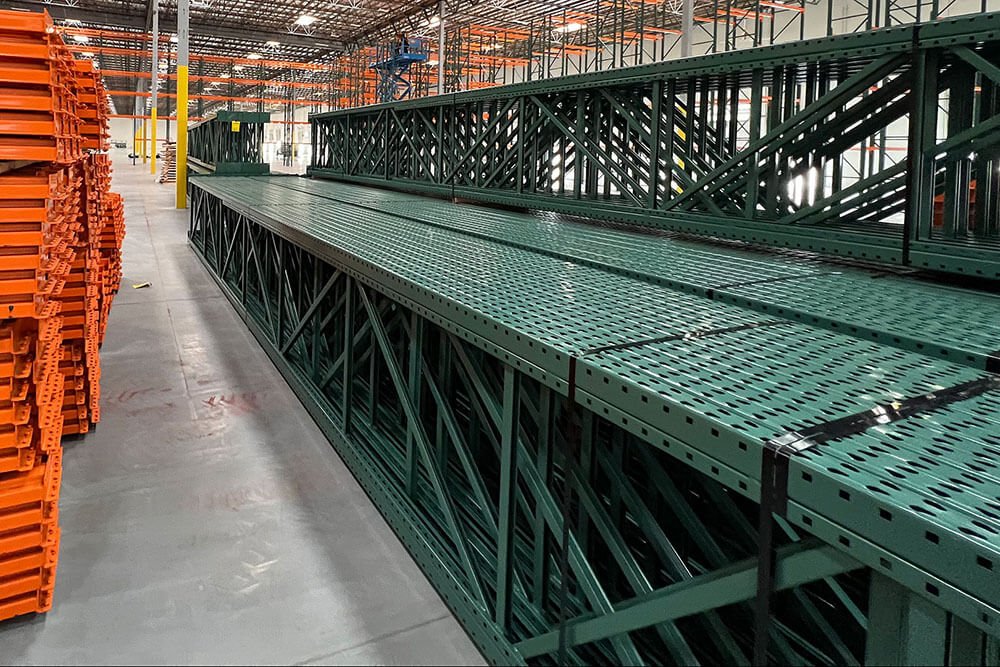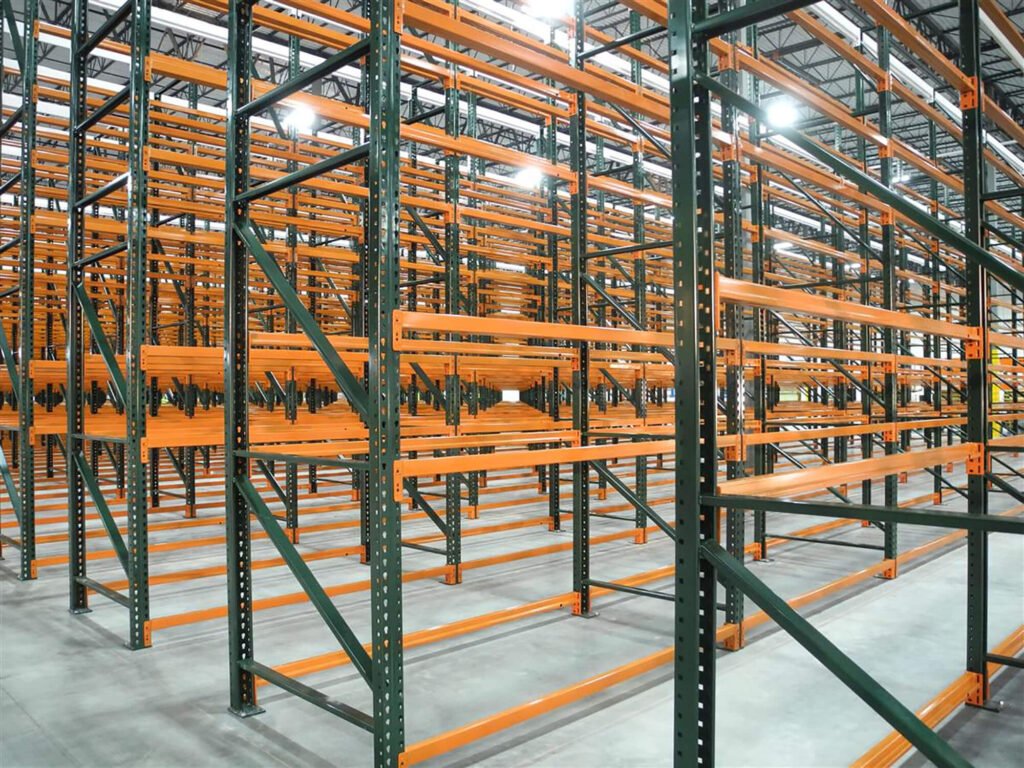In a well-functioning warehouse, efficiency and safety are two of the most important phrases that apply to all aspects of the facility’s operations, including pallet racking weight capacity. While this metric seems simple, many warehouse managers often don’t realize how important it is, thus choosing to disregard it altogether.
Different pallet racking systems have different load limits. This diversity gives rise to the problem of how to determine the weight capacity of your chosen inventory structure and what works best for your specific scenario.
To answer these two questions, you need to understand and consider numerous factors that are linked to the racking system itself and your stored product. Fortunately, this article covers it all! After reading, you’ll learn why pallet racking weight capacity is important and explore a step-by-step guide to compute this figure.
What Is The Maximum Value Of Pallet Racking Weight Capacity?
As mentioned above, pallet racking weight capacity varies greatly. So, it’s tough to pinpoint an exact maximum value. But theoretically speaking, to ensure the safety of the pallet rack, a pallet racking structure must be able to hold the greatest weight that you may potentially put on it.
Oftentimes, a standard pallet racking unit can support two pallets on a pair of beams, each of which weighs 2,000 pounds. In other words, it should be able to hold a total weight of 4,000 pounds per beam pair, which is equivalent to a normal pickup truck.
Now, consider having a warehouse loaded to the ceiling. With the estimation above in mind, you can figure out if your pallet racking structure can support the entire load. But that requires knowing the link between the stored products and their quantity in the racks.

Why Is Pallet Racking Weight Capacity Crucial?
Pallet racking weight capacity is an important consideration when you’re developing your warehouse layout. It’s also crucial to know how much weight your inventory system can bear in order to prevent warehouse mishaps. Exceeding these load constraints might result in devastating repercussions.
Besides being a safety reason for both your warehouse staff and stored products, wrapping your head around this topic also yields many great benefits, such as:
- Adhering to regulations: Some regions have codes and regulations that specify the maximum weight loads that pallet racking systems must be designed to support. Adhering to these load limits ensures compliance with safety rules.
- Extending the racking structure’s lifespan: It’s inevitable that overloading pallet racks can lead to wear and tear more quickly, potentially resulting in premature failure or the need for replacements. Thus, respecting pallet racking weight capacity extends the usable lifespan of these inventory structures.
- Saving replacement costs: By following the recommended weight limits, you can prevent unnecessary replacement, thus saving your business a big chunk of capital.
Key Factors That Influence Pallet Racking Weight Capacity
In this section, you’ll discover the critical elements that influence your storage system’s load capacity. Knowing these criteria allows you to increase pallet racking weight capacity while maintaining maximum warehouse safety.
Pallet Rack Beams
Choosing the proper horizontal supports for your inventory system is important to guaranteeing your warehouse’s efficiency and stability. Many aspects of pallet rack beams play a vital role in determining the structure’s weight capacity. When it comes to this factor, you’ll need to consider the following elements:

- Beam length: Longer beams tend to lower the load limits compared to shorter beams of the same width and material. This is because as the beam length increases, the bending under load also increases, thus reducing the maximum weight the pallet rack can safely support.
- Beam width: Warehouse operators often overly focus on the beam length and overlook this important factor. The width of the beam determines its resistance to bending. Wider beams result in less deflection under the same load compared to narrower beams, meaning the beam can withstand more weight.
- Beam material and design: It’s important to use high-quality materials (like steel) and hire skilled specialists who can assist you in designing a durable storage system tailored to your individual requirements (like 2C-S beams or tubular beams). This way, you can maximize your pallet racking weight capacity and keep your facility running smoothly.
- Beam level: The space between the top surface of one beam and the underside of another above it makes up one beam level. The maximum weight capacity per level decreases as the number of beam levels rises. Thus, your pallet racks should have fewer beam levels in case you plan to hold heavy objects.
- Vertical beam spacing: The distance of each beam level also impacts your pallet racking weight capacity. Typically, the vertical spacing between beam levels is 36 inches, while that between the ground and the first beam level is 48 inches. Kindly note that the load capacity will reduce when the beam spacing exceeds 48 inches.
- Load distribution: This factor also has a significant impact on the pallet beam weight load. Unevenly distributed loads of pallets might stress certain areas of the beams, causing them to bend or shatter under strain. To avoid this, ensure that your loads are appropriately spread throughout all beam levels.
Manufacturers of pallet racking systems always have their own specification charts to assist customers in selecting the suitable beam. Therefore, make sure to consult them and ask for these materials to make the most well-informed decision.
Pallet Rack Upright Frames
Besides beams, uprights are also an indispensable element that form a complete pallet racking structure. These vertical frames also contribute significantly to your racking load capacity. Thus, when choosing them, always assess the following factors:

- Upright material: Basically, there are two fundamental upright varieties: roll-formed steel type and structural steel type. Steel serves as the material for both, but the latter exhibits greater impact resistance and robustness. Thus, it can withstand heavier loads. However, roll-formed steel frames are more popular due to their affordability.
- Upright dimensions: In general, larger frames are designed to hold more weight. While the standard dimensions for roll-formed uprights are 3 inches deep by 3 inches wide (or 4 inches deep by 3 inches wide), those of structural posts are usually 4 inches deep by 1.5 inches wide.
- Upright cross-section shape: There are various cross-section shapes you can choose from, including teardrop, slotted, t-bolted, and keystone. While the teardrop style can help you swiftly and securely connect beams to the vertical posts, structural frames or bolted types with round or rectangular holes should generate a more robust pallet racking structure.
- Upright height: You may connect uprights to fit almost any height. Still, only splice them according to the manufacturer’s instructions. The height of vertical frames normally runs between 16 and 28 feet. As the height increases, uprights become more susceptible to lateral instability and failure under compressive loads.
- Bracing design: The bracing system of your uprights can influence the stability and weight capacity of pallet racks. These reinforcements are vital solutions to make up for the loss of load limits when you opt for higher frames. A properly spaced bracing design can distribute the loads more effectively, resulting in higher weight capacities.
- Base plates: Similar to the bracing element, base plates also help enhance overall racking stability and weight capacity by securing vertical uprights to the floor. Robust base plates prevent lateral movement of heavy loads as a consequence of impacts, loads, or seismic activity, ensuring that the specified weight capacity is met.
Pallet Rack Decking
Decking is often installed on pallet rack beams to offer extra support for palletized commodities. Its material varies, including bar grating, structural timber, and wire mesh decking. Since it is an adjunct to pallet racking systems, its weight capacity also becomes a crucial element to consider.
The recommended practice is to ensure that the decking’s load capacity is at least equal to that of the pallet rack beams on which it will be installed. Following this rule allows you to maximize the pallet loads you can store on the structure.
Governing Authorities That Regulate Pallet Racking Weight Capacity
Specifications regarding pallet racking weight capacity do not appear overnight. In fact, they have undergone numerous developments over the years to reach their current states. Currently, there are two primary organizations that regulate these weight capacity requirements:
- RMI (Rack Manufacturing Institute): This governing body represents every respectable pallet racking system producer, meaning many engineers and manufacturers of high-quality pallet racks belong to this institute.
- ANSI (American National Standards Institute): Being a nonprofit organization, ANSI provides universal design and production standards in a wide range of industries. One of their articles, ANSI-MH 16.1-2022, actually discusses pallet racking weight capacity.
Although knowing these organizations’ rules about the topic in question is essential, it’s still recommended to work with a specialist when estimating pallet racking weight capacity.
A Complete Guide To Determine Pallet Racking Weight Capacity
In principle, finding out how to calculate rack capacity is relatively simple. You compute the maximum weight of all pallet loads, then design your beams, uprights, and decking to at least surpass that projected limit.
However, in reality, there’s more to the aforementioned process. Each racking element from different manufacturers has different specified weight limitations. This poses a real challenge to ensuring that every component is compatible with its neighboring partner rather than becoming a weak link in the structure.

The following is a four-step approach that rack professionals use to calculate pallet racking weight capacity:
Step 1: Figuring Out Rack Beam Capacity
The most important thing to remember about rack beams is that their weight capacity is proportional to their length and width. These two elements both influence the overall structure’s load limitations due to the gravitational forces acting on a loaded rack beam.
Beams undergo compression, meaning the downward force applied by the live loads. They also adjust for a tension force that extends from the load’s center, travels sideways down the beam’s length, and transfers the loads to their vertical frame connecting point.
When estimating beam capacity, keep in mind that the longer the beam is, the wider it should be. For instance, suppose a 144-inch beam length has a maximum weight capacity of 3,000 pounds. By increasing its width, you can boost the capacity to nearly 8,000 pounds per pair.
Clearly, rack beams are essential in creating a sturdy and dependable storage system that meets your specific warehousing requirements. They must be robust enough to withstand a variety of changing situations. Besides the capacity, always anticipate your beams to bend somewhat under weight, which engineers often name deflection.
Step 2: Computing Upright Capacity
In addition to figuring out the rack beam capacity, it’s also crucial to compute upright limitations correctly. These vertical elements are designed to sustain the whole pallet racking system’s weight, which is gathered from the laden pallets, placed on the decks, transported via the beams, and delivered earthward via the uprights.
Uprights, or frames, absorb and transmit two weight types, each of which contributes to the total capacity they must sustain:
- Dead loads: This concept refers to the static weight of your unloaded pallet racking system. It is the entire gravitational pressure generated by the beams, uprights, decks, and other racking accessories. The pallet racking weight capacity must first be sufficient to sustain itself before it supports loaded pallets.
- Loaded pallets: Also known as live loads, loaded pallets represent the dynamic aspect of your racking system because they frequently move on your racks when first entering the warehouse or move off your racks for shipment to customers. Your pallet racking weight capacity must exceed the maximum number of its live and dead loads to ensure safety.
Engineers determine your upright capacity based on the frame measurements. This comprises the post height, its leg dimensions, and the spacing between them. Designers also estimate the maximum upright capacity based on the frame materials.
Step 3: Assessing The Bowing Of Pallet Rack Beams
Pallet racking producers employ high-quality steel for all elements in the structure, such as beams, uprights, decks, and base plates. While uprights and base plates should not bend, horizontal beams are designed to do so. This phenomenon occurs naturally in engineering.
In other words, beams sag somewhat when compressed or tensioned, as they are a bit elastic. This is a necessary component of beam design. In fact, it is intentionally made that way, so there’s nothing to worry about.
Typically, engineers ensure that rack beams’ deflection rate stays around 0.55% of their horizontal length to meet acceptable safety standards. Different manufacturers may need lower bowing tolerances for specific uses. For instance, in robotic applications like AS/RS (Automated Storage and Retrieval Systems), the rate is just 0.42%.
Oftentimes, the deflection rate must account for the highest risk of stress fatigue. Its main intention should be to warn warehouse staff and make them more cautious when they see a deflecting beam. It ensures that personnel understand the safety limitations of loading their racks and prevent overloading the structure.
Step 4: Calculating Deck Capacity
As a horizontal stabilizer, the racking deck helps distribute pallet weights evenly over beams and through the vertical columns. Loaded pallets often have unequal direct force distribution, and correctly constructed decks provide for low and high weight transfer contact.
When calculating pallet racking weight capacity, engineers often use the following two load types:
- Point loads: This load type refers to unequal weight concentrations. They are inconsistent load transfers in which one section of the contact surface is under more pressure than another. Skids are an excellent example of a point load since they gather the entire weight of a pallet and then transmit it in highly concentrated places over the deck or beam.
- Uniform loads: Unlike point loads, uniform loads mean weight is uniformly distributed among various contact surfaces. One typical example of this load type is a correctly loaded rack deck that transfers weight evenly over a beam.
Despite their importance in determining pallet racking weight capacity, decks aren’t used in every inventory system. There are certain methods that lay pallets directly on horizontal beams. Deckless systems are also a great example of the point-load type, and they require careful consideration to ensure stability and safety.
Conclusion
Bravo! You’ve now mastered the topic of pallet racking weight capacity. Understanding these load limitations and the variables that influence them is critical to ensuring that your warehouse runs smoothly and safely. Calculating weight capacity precisely also allows you to choose the best pallet racking systems for your facility.
In addition, this article elaborates on how to determine the maximum load limit for your pallet racking structure. Despite this in-depth discussion, it’s recommended to always consult a specialist regarding the matter.
Why? Well, there are many components and computations that might go wrong in this process. And even a small mistake can put warehouse staff in danger and lead to costly rectifications. Thanks for reading!




